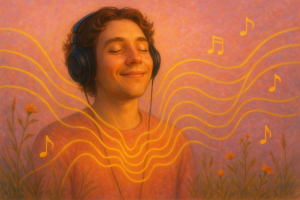The growing research surrounding sound healing suggests that meditative music and sound frequencies can help ease anxiety and reduce pain as well as improve a magnitude of other issues associated with physical and mental health.
While science is just beginning to catch on to the profound effects of musical frequencies as medicine, sound healing has been used in ancient cultures around the world since time immemorial. In fact, it’s quite likely that sound healing evolved at the very same time as Homo Sapiens. Music and humanity are inseparable.
From Ancient Greeks, to Indigenous American medicine men, to Tibetan monks it’s clear that somewhere humanity began to lose touch with the sacred knowledge of sound healing. What the Western World views as an alternative therapy or New Age spiritual practice, actually has roots in the birth of civilization and in cultures all over the world.
The first culture that is known to have practiced sound healing are the Aboriginal people of the country now known as Australia. A traditional instrument called the didgeridoo has been used by the Aborigines for the purposes of sound healing for over 40,000 years.
The didgeridoo is a traditional wind instrument that usually measures between 1 and 3 meters. They are made from hollow tree branches of eucalyptus wood or ironwood and are played by vibrating the lips to produce a continuous sound with a special breathing technique called circle breathing.
The didgeridoo produces a very deep, low-frequency sound that we can hear audibally, but the vibrations can also be felt in the body, especially if within close range. The low frequencies have healing effects on both humans and animals and have been used by elders in the Aboriginal tribes for the purposes of sound healing, simply by playing the instrument nearby. It has been used to heal broken bones, pulled muscles, and all kinds of other illnesses.
Many Westerners may be more familiar with the yogic traditions that have also utilized various elements of sound healing throughout the ages. Yogis use vibrations with instruments and with their voices. Baja, or seed syllables make up Sanskrit mantras, a type of healing prayer, that when sung have positive effects on the mind and body.
In the ancient Chinese practice of Qigong, certain chants and sounds are used to stimulate various organs in the body. There are 6 main healing sounds in Qigong known as Liu Zi Jue and involves coordinating breath and movement to specific sounds and vibrations. A book written by Tao Hongjing between 420-589, called On Caring for the Health of the Mind and Prolonging the Life Span, is the first to record this practice. The basis of the practice links to Chinese Traditional Medicine, which is widely practiced today.
Ancient Tibetan monks used singing bowls for spiritual ceremonies and for healing meditations. The first bowls were made from various metals, the oldest dating back 6000 years. The sound vibrations from the bowls, as well as the gong, allow for deep relaxation of both of the brain hemispheres and help relieve stress and release toxins from the body.
Singing bowls continue to grow in popularity around the world, with the most common form of modern sound healing being “sound baths” which are performed by playing crystal or metal singing bowls, gongs, and bells around a person who rests in meditation.
In Ancient Greece sound healing was performed to cure mental disorders. Greek physicians used flutes, lyres, and zitters in the practice of sound healing, and used vibration to help with digestive problems, mental health issues, and assist with sleep. Aristotle himself wrote about sound healing in his famous book, De Anima, mentioning that the flute music could arouse positive emotions and purify the soul.
Sound healing was popular in Ancient Egypt as well through a practice known as toning. Through toning the Egyptians manipulated vowel sounds with breath and voice to create a therapeutic chant that was believed to restore the harmonic rhythms of the body.
Entire structures were built in Egypt to maximize the therapeutic effects of sounds during ceremonies, including the pyramids along the Band of Peace. An archaeologist, Abd’el Hakim Awyan, studied the structures along the Band of peace. In a documentary called The Pyramid Code, he claimed that they are all created for harmonic healing and used the sounds of running water through underground tunnels to heal illness.
“Every chamber within the pyramid has a specific harmonic replicating the harmonics of the cavities of the human body. Sound healing techniques were then used to restore the patient’s body to the correct harmonics,” he said in the film.
Fascinatingly, the acoustician John Stuart Reid, claimed that the King’s chamber within the Great Pyramid of Giza, was created in a way that sound vibrations were maximized to amplify the power from ritualistic chants, and claims that his chronic back pain was cured while experimenting with sound inside the pyramid.
A clinical study by Mona Liza Chanda and Daniel J Levetin examined the neurochemistry of music and found that sound was a powerful tool to regulate mood and increase well-being. Sound hits all of the neurochemical systems for “reward, motivation, pleasure, stress, arousal, immunity, and social affiliation,” according to their article published in 2013.
Another study, published in the Journal of Evidence-Based Integrative Medicine, concluded that hourlong sound meditations helped reduce tension in the body, anger, fatigue, anxiety, and depression and increased feelings of overall well-being.
There are a variety of theories on why the effects of sound healing works so well. One of them is that sound works on the vibrational tactile effects of the body. A study of people with fibromyalgia found that two sound treatments a week of low frequency sounds decreased pain and was even able to reduce the need for pain medication, leading researchers to believe that sound stimulates touch fibers that have to do with perception of pain.
Another popular theory involves binaural beats. The idea is that the sound waves or frequencies can sync up human brain waves and eventually even change them. Brain activity is electrical and rhythmic and can be measured using an electroencephalogram or EEG. Through observing the activity of brain waves, scientists can see that binaural beats help the brainwaves shift with the exposure to different hertz.
As new theories emerge and more research is conducted, it is becoming increasingly clear that music as medicine and sound healing is far more than just a relaxation technique or pseudo-science for hippies. The research is incredibly promising that sound therapy could offer therapeutic benefits with almost no side effects.
Through studying the ancient history of sound healing, modern day humans can gain incredible knowledge on how to heal a variety of conditions naturally. As scientists begin to study the relationship between sound and the body and mind, they are re-discovering sacred knowledge.



